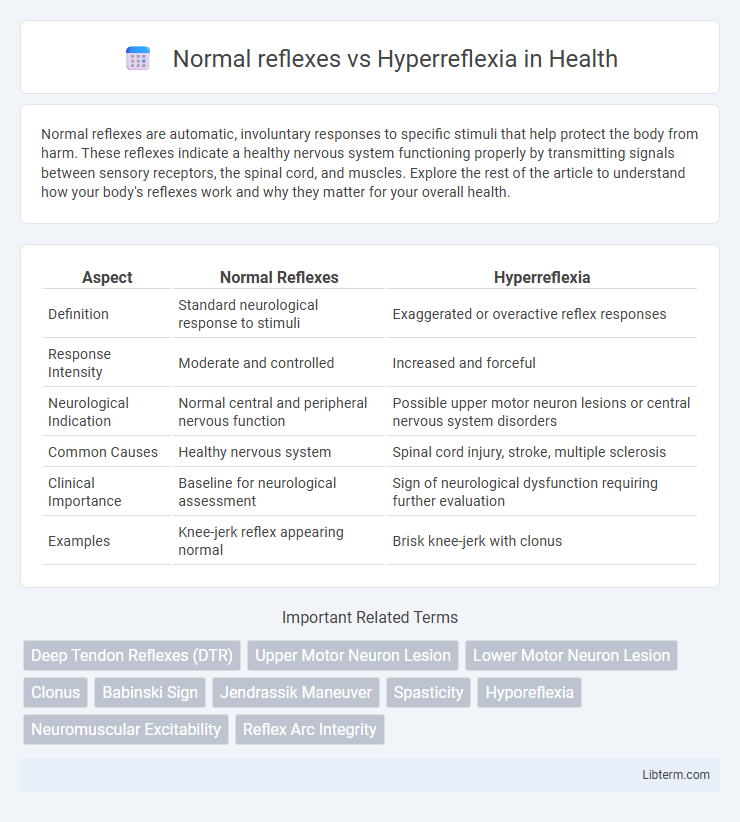Normal reflexes are automatic, involuntary responses to specific stimuli that help protect the body from harm. These reflexes indicate a healthy nervous system functioning properly by transmitting signals between sensory receptors, the spinal cord, and muscles. Explore the rest of the article to understand how your body's reflexes work and why they matter for your overall health.
Table of Comparison
| Aspect | Normal Reflexes | Hyperreflexia |
|---|---|---|
| Definition | Standard neurological response to stimuli | Exaggerated or overactive reflex responses |
| Response Intensity | Moderate and controlled | Increased and forceful |
| Neurological Indication | Normal central and peripheral nervous function | Possible upper motor neuron lesions or central nervous system disorders |
| Common Causes | Healthy nervous system | Spinal cord injury, stroke, multiple sclerosis |
| Clinical Importance | Baseline for neurological assessment | Sign of neurological dysfunction requiring further evaluation |
| Examples | Knee-jerk reflex appearing normal | Brisk knee-jerk with clonus |
Understanding Reflexes: An Overview
Reflexes are automatic, involuntary responses to stimuli, critical for assessing nervous system function; normal reflexes indicate intact neural pathways and appropriate muscle tone. Hyperreflexia, characterized by exaggerated reflex responses, often signals central nervous system abnormalities such as upper motor neuron lesions or spinal cord injury. Evaluating reflexes involves testing specific tendon reactions like the knee-jerk (patellar) reflex to differentiate between normal and pathological findings.
What Are Normal Reflexes?
Normal reflexes are automatic, involuntary responses to stimuli that help maintain body posture and protect it from harm by quickly reacting to sensory input. These reflexes, such as the knee-jerk reflex, typically produce moderate, symmetrical muscle contractions that indicate a healthy nervous system. Evaluating normal reflexes is essential in neurological exams to differentiate between typical neurophysiological responses and abnormal conditions like hyperreflexia, which involves exaggerated reflex responses.
Defining Hyperreflexia
Hyperreflexia is characterized by exaggerated or overactive reflex responses that exceed normal physiological levels, often indicating neurological disorders such as spinal cord injury or upper motor neuron lesions. Normal reflexes involve controlled, appropriate muscular responses to stimuli, maintaining balance and proprioception without excessive muscle contraction. Hyperreflexia typically manifests as brisk deep tendon reflexes, clonus, and sustained muscle spasms, signaling disruptions in inhibitory neural pathways.
Physiology Behind Reflex Arcs
Normal reflexes involve a balanced reflex arc where sensory neurons transmit signals to the spinal cord, synapsing with interneurons or directly with motor neurons to elicit a controlled muscle contraction. In hyperreflexia, this reflex arc becomes overactive due to disrupted inhibitory signals from the central nervous system, often caused by upper motor neuron lesions, resulting in exaggerated muscle responses. The physiology behind this involves impaired modulation of reflex pathways, altering the excitability of alpha motor neurons and leading to heightened reflex actions.
Key Differences: Normal Reflexes vs Hyperreflexia
Normal reflexes involve a balanced, controlled response to stimuli, reflecting proper functioning of the nervous system with typical muscle contraction and relaxation. Hyperreflexia is characterized by exaggerated or overactive reflex responses, often indicating disrupted inhibitory pathways in the spinal cord or brain, commonly associated with neurological conditions such as spinal cord injury or multiple sclerosis. The key differences include reflex intensity, with normal reflexes displaying moderate response, whereas hyperreflexia shows heightened, brisk reflex activity often accompanied by clonus.
Common Causes of Hyperreflexia
Normal reflexes involve a balanced response of the nervous system to stimuli, maintaining muscle tone and coordination. Hyperreflexia, characterized by exaggerated reflex responses, commonly results from upper motor neuron lesions, spinal cord injury, multiple sclerosis, or stroke. Other frequent causes include neurotoxicity from certain drugs, electrolyte imbalances like hypocalcemia, and severe anxiety or stress leading to heightened neural activity.
Clinical Assessment of Reflexes
Normal reflexes typically exhibit a brisk and consistent muscle response with a 2+ rating on the standard reflex scale, indicating healthy neurological function. Hyperreflexia is characterized by exaggerated reflex responses, often graded 3+ or 4+, and is commonly associated with upper motor neuron lesions or central nervous system disorders. Clinical assessment involves evaluating deep tendon reflexes using a reflex hammer, noting amplitude, symmetry, and response latency to differentiate between normal and pathological states.
Symptoms and Signs: When to Suspect Hyperreflexia
Normal reflexes exhibit consistent, moderate responses to stimuli, such as a brisk knee-jerk reaction without sustained contraction or excessive movement. Hyperreflexia presents with exaggerated reflex responses, characterized by clonus, sustained muscle contractions, and brisker-than-normal deep tendon reflexes, often accompanied by muscle spasticity. Suspect hyperreflexia when reflex testing reveals hyperactive responses, increased muscle tone, and signs of upper motor neuron lesions, typically indicating central nervous system pathology.
Implications for Diagnosis and Treatment
Normal reflexes indicate intact neural pathways and balanced motor neuron excitability, essential for diagnosing typical neurological function. Hyperreflexia, characterized by exaggerated reflex responses, suggests upper motor neuron lesions commonly seen in conditions like stroke or spinal cord injury. Identifying hyperreflexia guides clinicians in targeting treatments such as antispasticity medications and physical therapy to manage underlying neurogenic pathologies effectively.
Managing Reflex Abnormalities
Managing reflex abnormalities requires accurate differentiation between normal reflexes and hyperreflexia, characterized by exaggerated reflex responses often linked to upper motor neuron lesions. Treatment involves addressing the underlying cause, such as spinal cord injury or neurological disorders, while therapies like physical rehabilitation and medications (e.g., muscle relaxants or antispastic agents) help modulate abnormal reflex activity. Regular monitoring and tailored interventions optimize patient outcomes and prevent complications from excessive reflex excitability.
Normal reflexes Infographic

 libterm.com
libterm.com